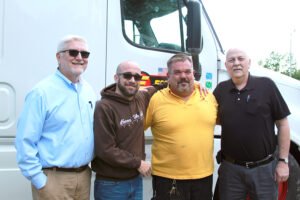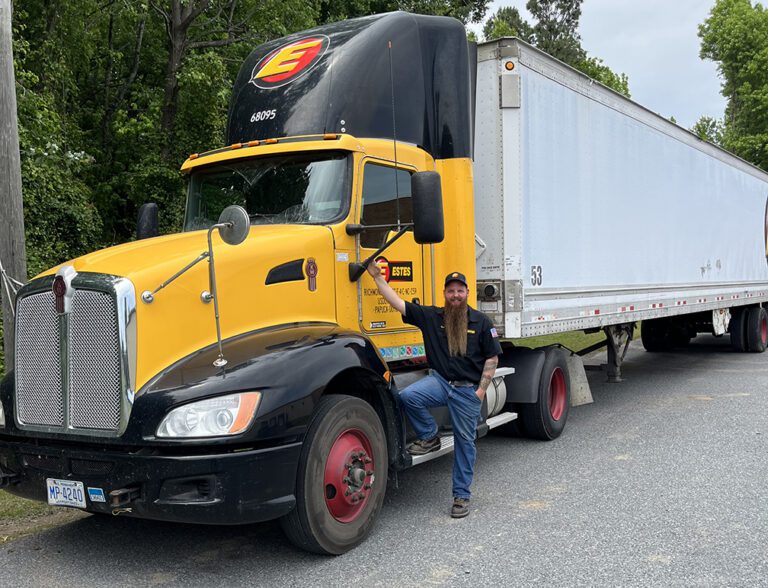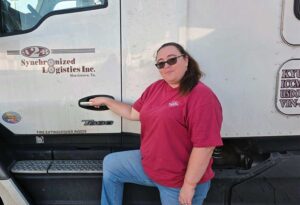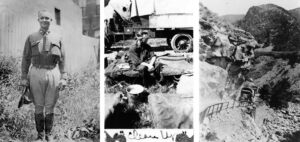This year, Estes Express Lines, based in Richmond, Virginia, celebrates a milestone — the 20th anniversary of the company’s in-house driver training program. If you’re looking for a success story from this dock-to-driver (DTD) program, look no further than driver-trainer Ryan Bell.
“Back in 2007, I was in a minimum wage job with a wife and a baby. We were living in my dad’s basement because we couldn’t afford an apartment,” said Bell, now 37. “I got started at Estes, worked the dock for a year and started seeing better pay checks. I moved to the switcher yard, and eventually bought a house and nice vehicles.”
Bell’s story doesn’t end there, however.
“After four years in the switching yard, I was asked if I wanted to do the driving school. I was, like, ‘Absolutely!’” he said, adding that he’d wanted to attend the school for a while — but back then the training program was held only twice a year.

Estes’ DTD program is open to all employees; anyone within the company can attend driver training with the approval of their terminal manager and regional safety manager.
The DTD program guides students through the process of earning a commercial driver’s license (CDL), obtaining clearances and undergoing the required drug tests. From there, it’s a two-week trip to driving school for a combination of classroom and field training. Estes even pays transportation costs and per diem expenses for employees.
“I went to driving school in December of 2011,” Bell said. “We were a class of 12. We stuck together, learned how to do pre-trip (inspections) and handle a 10-speed transmission. From there, I spent two weeks learning to drive city routes and eventually was sent to Aberdeen, North Carolina; (that was) my first real experience in a city.”
Bell’s love for the road has grown by leaps and bounds.
“I’ve been driving 12 years now, and I still love it every day,” he said.
Aside from driving for the company, Bell now has the opportunity to train new drivers through the Estes driver training program. He has been a driver-trainer at Estes’ High Point, North Carolina, location for three years. From High Point, Bell says they offer training to recruits from a large part of the country.
“The driver training program started in 2003 with the idea of offering in-house employees the career opportunity of driving a truck,” he said. “High Point was our first location.” Estes now operates a similar program in San Antonio.
“We do a class just about every month,” Bell said. “People from the Northeast, Midwest and Southeast all come to North Carolina for their training.”
The typical class ranges from eight to 18 students, although with the growing demand for training, Bell says he’s seen classes with as many as 24 students.
“There’s no shortage of students,” he said. “We want to offer employees already with the company the chance to grow and succeed.
“Back in 2011, I wanted more for my family — a better job — plus, I’ve always wanted to be a truck driver,” he continued. “This program made that a reality.”
While other carriers offer DTD programs, Bell says there are few things that set Estes’ training apart from the rest.
First, he said, Estes pays employees their regular salaries while they are in training.
“We pay you to learn,” he said. “There are schools out there charging $5,000 to $7,000 to teach you to drive a truck. I’ve heard people say they learned more about playing poker than trucks while in the class.”
In addition to an automatic transmission, Estes trains its drivers to operate a 10-speed transmission.
“Our drivers can have no restrictions on their licenses,” Bell said. “Being able to drive only an automatic is a no-go.”
This requirement, he says, is good overall, but students vary in their ability to learn the 10-speed transmission.
“We teach students to upshift, downshift and double clutch,” he said. “A lot of our students have never even driven a stick-shift car — but that’s often a good thing. Many who drive one have invariably learned some bad habits along the way, and we have to overcome them.”
Estes’ DTD program originally had a minimum age requirement of 23, but it has been lowered to 21, Bell said, bringing a new dynamic to the classroom.
“Some of the younger students haven’t even been driving a car very long,” he said. “While they have a learning curve in terms of driving, they are often far ahead of older students in terms of technology.”
Mastering the use of hand-held devices and computers in trucks — learning what is really a step beyond driving — is typically easier for younger students, Bell noted.
To better serve the students — and ultimately the carrier’s clientele — Bell says that Estes’ DTD program is constantly evolving to match changes in the industry. However, he noted, the base education remains regimented.
“Driving a truck isn’t too different today than it was when I went through the training program in 2011,” he said. “It’s electronic logging, devices that track pick-up and delivery, and other technological changes that drivers have to adjust to. We just teach them how to drive the same way we have for as long as the program has existed.”
Bell is particularly proud of the success rate of his students.
“I can say that there have been only a handful who haven’t been able to pull-through the program,” he said. “And we don’t want to see anyone go through the program and not accomplish their goals. We do everything we can to help students succeed.”
Overall, Estes’ DTD program has a high success rate and turns out good drivers in terms of their level of safety and mindfulness when driving a truck, he added.
Since the program’s inception back in 2003, the number of drivers trained annually has generally trended upward every year. That first year, about 60 students successfully completed the program; in 2022 there were nearly 300 graduates.
While the training program does not produce the majority of Estes’ new driver hires, the percentage is increasing, and that includes women.
“We are seeing an increase of women employees coming through,” Bell said. “And we’re seeing a much better turnout in diversity throughout the program in general. We want to hire from within, and this program allows us to do so.”
Bell says he does notice a few students who struggle — but not because of a lack of ability. It’s typically because of a language barrier.
“We have had a few students from foreign countries who have difficulty with the language barrier. This usually creates problems in classroom training,” he said, adding that, for the most part, the students and instructors are able to overcome these barriers, resulting in successful completion of training.
When asked about his memorable moments in teaching students to drive, Bell said, “It’s very humbling. You don’t realize what graduating from our program means to people. Some are crying when they get their certificate.”
Most students, Bell said, enter the program with the same goals: to earn more money, give their family a better opportunity and to see the country. By graduation day, however, being given the opportunity to grow and thrive in a driving career means much more to students.
“It means a lot to me to be able to teach them and be a part of their lives,” he said. “I just want to help them along their way, and it is very humbling.”
Since retiring from a career as an outdoor recreation professional from the State of Arkansas, Kris Rutherford has worked as a freelance writer and, with his wife, owns and publishes a small Northeast Texas newspaper, The Roxton Progress. Kris has worked as a ghostwriter and editor and has authored seven books of his own. He became interested in the trucking industry as a child in the 1970s when his family traveled the interstates twice a year between their home in Maine and their native Texas. He has been a classic country music enthusiast since the age of nine when he developed a special interest in trucking songs.
















This article is very uplifting for the few folks that truly love to drive an 18 wheeler. I too was a trainer at my job. However through all of my 40+ years of experience now retired, most did not even come close to the dedication that I gave. Being a true professional driver means not only doing a proper pre and post trip. It also consists of maintaining a clean vehicle, majority of drivers are slobs. Also pre-trips mean exactly that, if you find something wrong you don’t leave, you get the problem fixed no matter the pressure from dispatch or the mechanics.